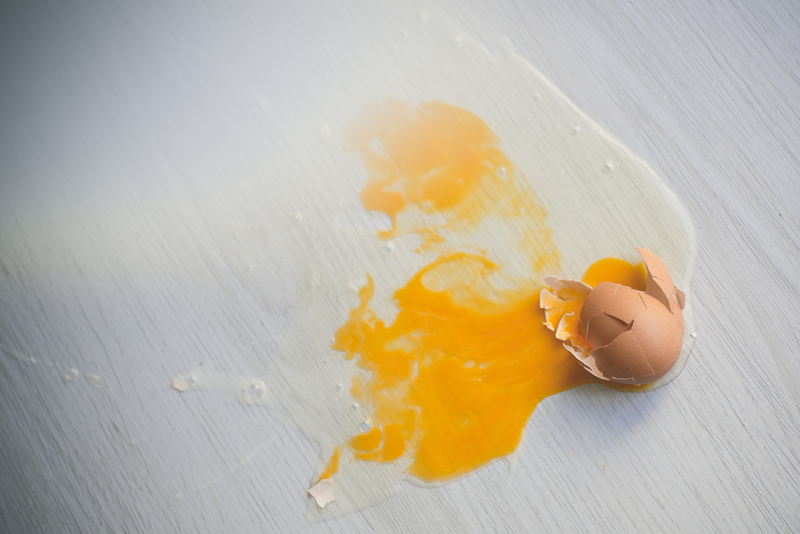Quick Tips for Cleaning Mouldy Window Sills
Posted on 19/09/2025
Quick Tips for Cleaning Mouldy Window Sills
Window sills are often the first spot in a home where mould can begin to grow. This is due to the combination of external moisture, condensation, and lack of proper ventilation. If not addressed, mouldy window sills can not only look unsightly, but also pose health hazards and even cause permanent damage to the structure of your home. That's why it's important to learn the most effective and quick ways to tackle mould on window sills.
In this comprehensive guide, you'll discover:
- What causes mould to grow on window sills
- Health risks of household mould
- The best cleaning solutions for mouldy window frames and sills
- Step-by-step methods for cleaning mouldy window sills quickly and effectively
- Tips for keeping mould from returning
- When to call in professional help

Why Do Window Sills Get Mouldy?
Window sills are prime spots for mould because they frequently collect condensation. When warm, moist air inside your home meets the cooler surface of the window, droplets form and settle on the sill and frame. If this moisture isn't wiped away or if the area remains damp, mould spores--which are always present in the air--begin to grow.
Other factors that can contribute to mould on window sills include:
- Poor insulation leading to cold surfaces
- High indoor humidity (often over 60%)
- Lack of ventilation in bathrooms, kitchens, or bedrooms
- Leaky windows or deteriorated caulking allowing rainwater to seep in
- Obstructed window sills (covered by curtains or blinds, reducing airflow and sunlight)
The Health Risks of Living with Mouldy Window Sills
Many homeowners underestimate how hazardous black mould or mildew on window ledges can be. Prolonged exposure can trigger:
- Allergies and frequent sneezing or coughing
- Skin irritations and rashes
- Respiratory concerns such as asthma or sinus infections
- Headaches, fatigue and eye irritation
Infants, elderly individuals, and people with weakened immune systems are particularly susceptible to the adverse effects of mould. For this reason, it's crucial to address the issue as soon as mould appears.
Best Cleaning Products and Solutions for Mouldy Window Sills
Before you start cleaning, make sure you have all your materials on hand. Here's what you'll need:
- Rubber gloves
- Protective eyewear and a mask
- Microfiber cloths or paper towels
- Spray bottle
- Old toothbrush or soft scrub brush
- Effective cleaning solutions (see below)
Never mix cleaning chemicals, especially bleach and ammonia. Always ensure the room is well-ventilated when tackling mould.
Homemade Mould Removal Solutions
- White Vinegar: Pure distilled vinegar kills up to 82% of mould species. Spray it on, let it sit for 1 hour, then wipe clean.
- Baking Soda: Dissolve 1 teaspoon in a spray bottle of water. Shake, spray and scrub the area. Rinse and dry.
- Hydrogen Peroxide (3%): Spray directly on the surface and let fizz for 10 minutes before wiping off.
- Lemon Juice: Its natural acidity can break down mild mould spots.
Commercial Cleaning Products
- Antifungal or antimicrobial sprays specifically formulated for window sills
- Standard household bleach diluted (1 part bleach to 10 parts water)
- Ready-to-use mould and mildew removers (always read directions before use)
Step-by-Step Guide: How to Quickly Clean Mouldy Window Sills
Cleaning mould from window sills and frames doesn't have to be a daunting task. Follow these quick and effective steps for the best results:
Preparation
- Protect yourself: Wear gloves and a mask, as mould spores will become airborne during cleaning.
- Open the window: Increase airflow around the workspace.
- Clear the area: Remove curtains, blinds, or plants from the window sill and nearby surfaces.
Cleaning the Mould
- Spray your cleaning solution generously onto the affected area. Unlike dust, mould sits deep in wood and grout, so ensure good saturation.
- Let the solution sit: Give it 10-30 minutes to break down the mould's roots.
- Scrub the sill: Use a toothbrush or small brush to gently dislodge the black or green mould. Be thorough, especially with corners and grout lines.
- Wipe away residue: Use a damp microfiber cloth or paper towel to remove the loosened mould. Repeat if necessary until the area appears clean.
- Rinse (if required): Use a clean, damp cloth to wipe away any cleaning residue, especially if you used vinegar or hydrogen peroxide.
- Dry the window sill completely: This is crucial. Use a dry towel or leave the window open to air dry.
Tip: For stubborn stains on wooden window frames or painted surfaces, avoid abrasive scrubbing which can damage the finish. Instead, repeat the cleaning process or use gentle solutions.
How to Remove Mould from Wooden Window Sills
Cleaning mould off wooden window sills requires special care to avoid damaging the wood. Here's how:
- Avoid excessive moisture--use a lightly damp cloth rather than soaking the area.
- Choose less harsh cleaning agents (vinegar, baking soda, or commercial wood-safe mould removers).
- After cleaning, apply a wood treatment oil to restore and protect the finish.
How to Clean Mould off UPVC and Painted Window Sills
UPVC (vinyl) and painted window sills are easier to clean but can discolor if you use too-strong chemicals. Always test any cleaner on a small hidden spot first.
- You can use diluted bleach, vinegar or a commercial UPVC cleaner.
- Don't let cleaning solutions sit for too long on painted surfaces to avoid peeling or fading.
- Wipe dry immediately after cleaning.
Preventing Mould Growth on Window Sills
While knowing how to remove and clean mould from window sills is vital, prevention is best. Here's how you can stop mould from coming back:
Reduce Indoor Humidity
- Use a dehumidifier in problem areas, especially during wet seasons.
- Ensure extractor fans are working properly in your kitchen and bathroom.
- Open windows regularly, even in winter, to allow airflow.
Regular Maintenance
- Wipe down window sills each morning to remove condensation.
- Fix leaky seals or cracked caulking as soon as you notice them.
- Remove clutter from sills so air and sunlight can reach all surfaces.
Install Insulation and Ventilation Solutions
- Double glaze your windows to reduce condensation.
- Invest in trickle vents or window fans to improve ventilation.
Extra Tips: Cleaning Mould from Window Sills Naturally
- Tea tree oil: Mix 1 teaspoon with 1 cup of water in a spray bottle. Spray on, leave for 1 hour, then wipe dry.
- Grapefruit seed extract: Mix 10 drops in a cup of water. Spray and let air dry.
- Sunlight: If possible, keep curtains open and let sunlight hit window sills--UV naturally kills mould spores!
When to Call a Professional
Sometimes, mould damage is too extensive for DIY cleaning. Get professional help if:
- Mould covers an area larger than one square meter
- There are signs of rot or warping on wood sills
- You or your family experience persistent health problems
- You notice a musty odour that persists despite cleaning
Professionals use HEPA vacuums and specialised fungicides to remove all traces of mould and can advise on deep-seated humidity or insulation issues.

Frequently Asked Questions about Cleaning Mouldy Window Sills
Is it safe to clean mould from window sills myself?
Yes--if the patch is small, you have no allergies, and you use proper safety precautions. Always wear gloves and a mask, and avoid mixing cleaning products.
Can bleach damage my window sill?
Bleach can discolour or damage painted and wooden surfaces. Only use on white UPVC or as a last resort and always rinse thoroughly.
How often should I check for mould on window sills?
Ideally, inspect your window sills for mould and mildew at least once a month--more often during rainy or humid spells.
Why does mould keep coming back after I clean it?
If you don't address underlying moisture or ventilation issues, mould can quickly return. Ensure the area is kept dry and that you're regularly ventilating the space.
Conclusion: Keep Your Mouldy Window Sills Spotless and Healthy
Cleaning mouldy window sills is essential not just for aesthetics, but for the health and safety of everyone in your home. With these quick tips and effective techniques, you can banish mould, maintain a fresh living environment, and even prevent future growth. Always remember the golden rule: tackle moisture first, and mould will have nowhere to thrive.
A clean window sill brightens the view and improves your indoor air quality--don't let mould steal its spotlight!



